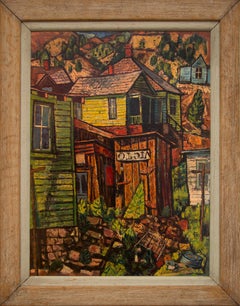Paul Kauvar Smith Art
Paul Kauvar Smith, born in Cape Girardeau, studied commercial art and design at the St. Louis School of Fine Arts from 1915–16 with a brief interruption during World War I. After the war, he returned to the School of Fine Arts and went on to study at the Washington University in St. Louis. In 1921, Smith moved to Colorado to study under John E. Thompson at the Denver Academy of Fine and Applied Arts. Thompson, who is considered to be the pioneer of modernism in Denver, was a strong influence on Smith. In 1923, Smith was hired by the Academy as an instructor. That same year, his work was accepted for the first time for display at the Denver Art Museum and he was also awarded two solo exhibitions. The museum later added his work to their Anne Evans collection. In 1959, the Denver Art Museum also reproduced one of his paintings titled Houses at Victor for their Western Heritage exhibition catalog. Smith became a permanent resident of Denver and was a member of the American Artists Professional League, as well as Colorado and Denver Art Guilds. He also joined a Denver group called The Colorado Fifteen. Fifteen came into existence in 1948 as an association of professional artists dedicated to the avant-garde. Smith died in Denver in 1977.
1950s Abstract Geometric Paul Kauvar Smith Art
Oil, Board
1950s American Modern Paul Kauvar Smith Art
Oil
1940s American Modern Paul Kauvar Smith Art
Oil, Canvas
1930s American Modern Paul Kauvar Smith Art
Gouache, Board, Watercolor
2010s Abstract Geometric Paul Kauvar Smith Art
Wood, Paper, Ink, Acrylic, Cardboard
2010s Abstract Geometric Paul Kauvar Smith Art
Ink, Acrylic, Cardboard
1940s American Modern Paul Kauvar Smith Art
Canvas, Oil
20th Century American Modern Paul Kauvar Smith Art
Canvas, Oil
1940s American Modern Paul Kauvar Smith Art
Canvas, Oil
1940s American Modern Paul Kauvar Smith Art
Canvas, Oil
1950s American Modern Paul Kauvar Smith Art
Oil, Canvas
2010s Abstract Geometric Paul Kauvar Smith Art
Wood, Ink, Acrylic, Cardboard
2010s Abstract Geometric Paul Kauvar Smith Art
Ink, Acrylic, Wood Panel, Cardboard
1940s Abstract Geometric Paul Kauvar Smith Art
Oil, Board
Late 20th Century American Modern Paul Kauvar Smith Art
Canvas, Oil
Mid-20th Century American Modern Paul Kauvar Smith Art
Oil, Board
1930s American Modern Paul Kauvar Smith Art
1950s Abstract Expressionist Paul Kauvar Smith Art
Canvas, Oil
Paul Kauvar Smith art for sale on 1stDibs.
Artists Similar to Paul Kauvar Smith
- Where is Paul Smith from?1 Answer1stDibs ExpertMarch 22, 2022Paul Smith is from Beeston, Nottinghamshire, England. He was born there on July 5, 1946. The fashion designer worked for a Savile Row tailor in London before opening his own shop in Nottingham in 1970. Find a collection of Paul Smith on 1stDibs.
- Is Paul Smith a luxury brand?1 Answer1stDibs ExpertMarch 22, 2022Yes, Paul Smith is a luxury brand. The British design house produces men's and women's clothing, gift items and home décor using fine quality materials and sells them at high price points, fitting the definition of luxury fashion. On 1stDibs, shop a range of Paul Smith apparel and accessories.
- Is Paul Smith good quality?1 Answer1stDibs ExpertMarch 15, 2024Yes, Paul Smith is generally of good quality. Since its founding in 1970, the British fashion brand has earned a reputation for producing well-tailored pieces and finely crafted accessories out of premium materials. Online reviewers frequently cite how long Paul Smith pieces last and the value that they offer for their price. Find a range of Paul Smith apparel and accessories on 1stDibs.


